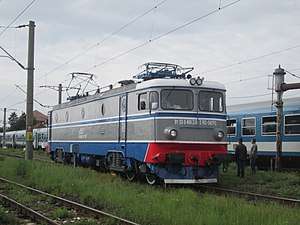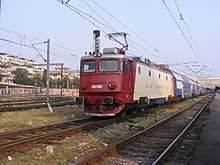CFR Class EA
| Electroputere LE 5100kW CFR 060-EA/EA1/EA2 (pre-1980) CFR Clasa 40/41/42 (post-1980) | |||||||||||||||||||||||||||||
|---|---|---|---|---|---|---|---|---|---|---|---|---|---|---|---|---|---|---|---|---|---|---|---|---|---|---|---|---|---|
 | |||||||||||||||||||||||||||||
| |||||||||||||||||||||||||||||
| |||||||||||||||||||||||||||||
| |||||||||||||||||||||||||||||
| |||||||||||||||||||||||||||||
The Electroputere LE 5100, otherwise known as CFR Class 40/41/42 is a class of electric locomotives built for the Romanian Railways (CFR) for use on the Romanian electrified network. Over 1000 Class 40s were constructed by Electroputere (EP) under ASEA license in EPs Craiova Works from 1967 to 1991.
Entering service in 1965, the Class 40 also operated on private railroads after the repeal of CFRs monopoly on rail transport. The vast majority of all the engines are still in service, as of 2018, having become a icon for the Romanian Railways.
History

Following the plans of Communist Party, the Romanian railway network was to reduce its operating steam engines to under 25% of the total number of engines. Since the start of dieselisation in Romania and the electrification of the first railway sector between Bucharest and Brașov, communist ambitions were to improve local industrial capacities, remove dependency on outside sources and reduce conventional fuel consumption.[1] Since Romania did not develop an electrical locomotive to suit these ambitions, foreign partnerships were searched to design and home build a working horse for the Romanian Railways. Even if Romania has previously signed partnerships with Sulzer for the development of its diesel-electric locomotives, for the electric locomotive a partnership was signed with Sweden's Allmänna Svenska Elektriska (ASEA).
Before signing the contract with ASEA, trials were made on the Predeal-Brasov mainline between 1963 and 1965. The locomotives used were:
- 2 locomotives of SNCF class BB 12000, made by Alstom
- a locomotive made by LEW Hennigsdorf, the predecessor of the DR Class E 251
- 2 locomotives made by Škoda Works Plzen, type 41E (this loco would later become the backbone of the Bulgarian Railways in 1963)
- 2 locomotives made by ASEA type Rb (these would also go to Yugoslavia in 1967 to be the basis of JZ class 441)
Builders

Allmänna Svenska Elektriska AB
10 locomotives were made by ASEA after an agreement was reached in 1965. The locomotives were numbered from 060-EA-001 to 060-EA-009, and another unit, 060-EB-001 fitted with experimental electrical equipment (regenerative braking and thyristors) was delivered, though it was proven to be faulty and expensive to maintain and rarely used until 1991, when it was rebuilt into a regular 40 class unit. The 10 units were basically a SJ Rb but with heavy modifications (longer wheelbase, 6 axles), that were made until 1966. Out of all the 10 units that were delivered, only a few survive up to this day, 060-EA-001 being destroyed in an accident at Apața in 1990, whilst a number of them have been renumbered/refurbished.[2]
Electroputere Craiova
All the engines that were built after 1966 were built by the Electroputere Craiova factory and have been identified by the EA designation. These are all 6 axle, 5100 kW engines, produced in a number of over 1000 units between 1967 and 1991. Electroputere (EP) manufactured both the mechanics and electronics of the engines, after mechanics for the engines stopped to be manufactured in Reșița, EP took care of the entire manufacturing for these engines and had a yearly output of 150 engines per year. The differences between EA class and EA1 class (classes 40 respectively 41 under the new classification) is that class EA is designed for regular passenger trains and freight trains, being limited to 120 km/h whilst the class EA1 is designed for higher speed fast trains with a maximum speed of 160 km/h.
_at_Bucuresti_Nord.jpg)
In 1974, 060-EA1-122 (later 41-0122-6) was built using experimental 200 km/h axles and gear ratios and used as a test locomotive under the classification of EA2 (thus becoming 060-EA2-122, nicknamed "The General" due to this high ranking status). After the experiments proved successful, the axles and gear ratios were transferred to 060-EA2-302 (later 42-0302-2, now 420 302 under the UIC classification) in 1977 and 122 was soon converted into an EA1 machine using 160 km/h axles and gear ratios. 302 soon became the new "general", breaking the speed records for Romanian Railways twice, once in 1997 during testing of the Eurofima-based passenger cars on the Floresti Prahova-Buda stretch of the Ploiesti-Brasov mainline, and the second time in 2007 on the Faurei ring during testing for Astra Arad passenger cars. In recent years it has been neglected and due to this, one of the bearings is damaged, resulting into the limitation of the speed to 160 km/h.
The design proved to be very successful, and after an agreement in 1970, Yugoslav Railways decided to buy a number of locomotives that became the JŽ Series 461 from Electroputere, after CFR also agreed to buy Rade Koncar made locomotives. They were first delivered between 1971 and 1973, and they became so successful, that JŽ brought a second batch between 1978 and 1980. After the breakup of Yugoslavia, they were passed onto ŽS, ŽCG and MŽ. A number have been modernised, having been turned into 461.2 series (Serbia) and 462 series (Macedonia). Further exports were achieved in 1986 and 1987 when the Bulgarian State Railways brought another number of units, that were also modernized, becoming the 46.2 series (the original series number being 46). Modernization of these locomotives is done by Rade Končar Zagreb, REMARUL 16 Februarie Cluj and RELOC Craiova.
Modernisations for the Romanian Railways' locomotives have been done by different companies, and the first of such concepts appeared in the late 1990s when Siemens (along with a few subcontractors) modernised a few units to CFR Class 45. The modernisations were a success and the locomotives were hailed as "Romania's firs modern electric locomotives", produced between 1998 and 2002. Production was stopped though, and only a small number were made, all locomotives numbers beginning with 3xx. They were later rebuilt by Softronic Craiova, and up to this date only 1 unrefurbished locomotive runs in regular service, seen mostly on Bucharest-Constanta mainline. Starting with 2006 and 2007, a number of locomotives were rebuilt by Softronic and PROMAT as CFR Class 47, being a more successful modernisation. Refurbishments are done by SCRL Brașov, RELOC and Softronic Craiova, REMAR Pascani and Cluj and PROMAT.
Aside from the exported models to ŽS and BDŽ, these locomotives operate in Hungary and Slovakia. A number of examples are operated by Magyar Magánvasút Zrt., Train Hungary, Prvá Slovenská železničná, Foxrail and Floyd ZRt., and are used in regular service in those countries. In 1998, OSE (Greek Railways) hired locomotive 060-EA-056 (manufactured 1968) to operate during the opening of the first electrified Greek railway line from Thessaloniki to Idomeni/Gevgelija, and was temporarily used until it was returned to CFR.
References
| Wikimedia Commons has media related to CFR Class 40. |
| Wikimedia Commons has media related to CFR Class 41. |
| Wikimedia Commons has media related to CFR Class 42. |

.jpg)